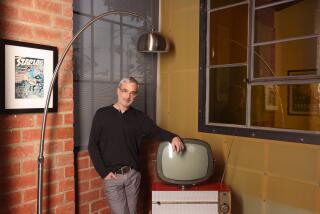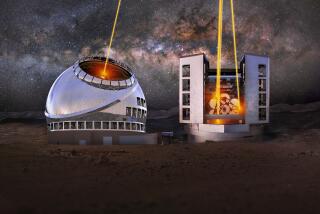PETER R. BAKER: Reaching for the Stars
It boasts computer-generated special effects from three of the top visual effects houses in Hollywood. It was filmed in exotic locales ranging from the Chilean Andes to Paris and from Mauna Kea, Hawaii, to Aspen, Colo. Its budget is almost double the industry standard.
The latest Steven Spielberg project? Not by a light year. “The Astronomers” is an ambitious, six-week hourlong series produced by KCET in Los Angeles for public television with a record $5.3 million grant from the W.M. Keck Foundation.
The science-made-simple series, narrated by actor Richard Chamberlain, claims that more has been learned about the universe in the past 10 years than in the last several centuries. Center stage in the series belongs to the astronomers themselves, who spend their lives shedding light on dark matter, black holes, quasars and planets outside our solar system.
Series producer Dr. Peter R. Baker, a Peabody and DuPont-Columbia award winner, talked to Daniel Cerone about “The Astronomers.”
Whose idea was it to create “The Astronomers?”
The idea for “The Astronomers,” initially, came from (executive producer) Blaine Baggett, who had been producing a PBS series called “Spaceflight.” He’d been impressed in making “Spaceflight” by how many space probes were contributing to astronomy.
What was the greatest challenge in making the series?
Teaching the science at a level people can get a hold of, and making it very pretty. It’s an attractive series visually, in three ways really. First, there are very glamorous locations around the world, because astronomical locations are usually found on top of a mountain or in a beautiful wilderness, well away from big cities. And we shot it in a way that emphasizes that. Second, the instruments that the astronomers use are stunning, big, beautiful telescopes the size of a house. Third, there’s the animation. The companies really had to stretch themselves to present these visions.
Did your staff of producers know anything about astronomy before this series?
One of my first priorities was what we called astronomy school in conjunction with Cal Tech, one of the leaders in astrophysics. They were good enough to set up tailor-made seminars for us. We spent nine half-days in astronomy school right near the beginning of the project. We were able to sit with some of the world’s most brilliant astrophysicists.
I have a Ph.D. in physics, and Don Goldsmith, the writer of “The Astronomers” companion book and co-writer of the series, has a Ph.D. in astronomy. But the producers didn’t have a formal academic background in science for the most part. We picked them for their filmmaking abilities. It was an interesting risk. It made it harder in planning the production, but it paid off. The producers brought a human touch, a human story, in a way that very few specialist science producers would be able to.
What is the general perception of scientific series?
Most people think of science as just stuff way beyond them, all meters and test tubes and statistics and words and jargon that they just can’t understand. If I think of science series in general, I think most are very, very information intensive in the scientific sense. They are often designed to present the most complete and detailed picture of the state of the science. And the trouble is that goes over a lot of people’s heads.
How did you make “The Astronomers” accessible to a wide audience?
You need something that can get people involved. Really the way to do that is to combine the science with people and their individual stories. In most programs, the participants in the show know each other and work together. So we’re not just going to the people who are the most knowledgeable in the field. We really limited ourselves to a small group of astronomers so the audience can get to know them, get under their skin and see what drives them.
What’s the value of a series like this?
It’s so important for people to have a realistic sense of what science is and how it works. I think this is a true portrait of what goes on. There’s nothing highty about it or self- important. And hopefully some kids will be pulled in that direction, which we badly need. We need scientists and engineers. Science is so exciting, but it’s so friggin’ difficult for most people you really need something exciting to get it across.
Part 1 of “The Astronomers” airs Monday at 8 p.m. on KCET and 9:30 p.m. on KVCR, with new episodes every Monday night. It begins Tuesday on KOCE at 8 p.m., with new episodes every Tuesday.
More to Read
The complete guide to home viewing
Get Screen Gab for everything about the TV shows and streaming movies everyone’s talking about.
You may occasionally receive promotional content from the Los Angeles Times.






